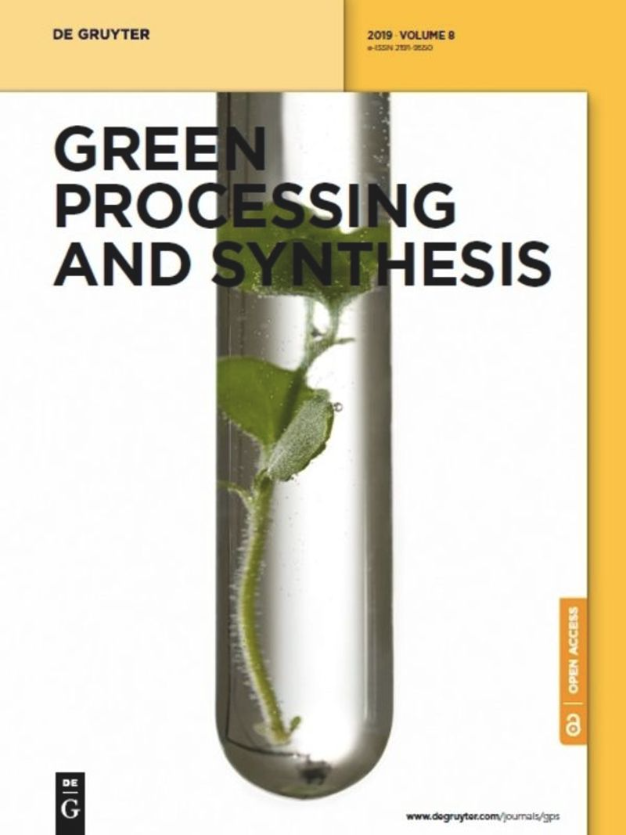用苦楝成熟果实提取物制备纳米银的绿色制备、表征及其生物学特性
IF 3
4区 工程技术
Q2 CHEMISTRY, MULTIDISCIPLINARY
引用次数: 5
摘要
摘要在目前的研究工作中,试图利用苦楝成熟的果实提取物合成银纳米颗粒(MA-AgNPs)。使用各种表征技术,如紫外-可见光谱分析、热重分析(TGA)和扫描电子显微镜(SEM)来证实AgNPs的合成。通过紫外-可见光谱跟踪生物还原和颜色变化,而SEM证实尺寸为2–60的AgNPs nm。TGA显示了合成的AgNPs的稳定性。根据抑制区(ZI)、最小杀菌浓度和对测试菌株的最小抑制浓度来评估基于M.azedarach的AgNPs和果实提取物的抗菌潜力,其中NPs的活性较高(铜绿假单胞菌ZI=22)。2,2-二苯基-1-苦基肼(DPPH)和(2,2-二嗪基-[3-乙基苯并噻唑啉]-6-磺酸)(ABTS)测定显示,NP具有显著的抗氧化活性。提取记录的IC50值分别为340和350 μg·mL−1对抗DPPH和ABTS,而AgNP的相应值分别为40和58 μg·mL−1。研究表明,与亲代提取物相比,工程NPs具有良好的生物活性,因此可作为抗菌剂和抗氧化剂用于药物设计;然而,在将其应用扩展到生物系统之前,应该在这方面进行进一步的体内探索。本文章由计算机程序翻译,如有差异,请以英文原文为准。
Green fabrication of silver nanoparticles using Melia azedarach ripened fruit extract, their characterization, and biological properties
Abstract In the current research work, an attempt was made to synthesize silver nanoparticles (MA-AgNPs) utilizing the ripened fruit extract of Melia azedarach. Various characterization techniques such as UV-visible spectroscopic analysis, thermal gravimetric analysis (TGA), and scanning electron microscopy (SEM) were used to confirm the AgNPs synthesis. The bioreduction and color changes were tracked by UV-visible spectroscopy while SEM confirmed AgNPs of size 2–60 nm. TGA revealed the stability of the synthesized AgNPs. The antibacterial potential of the M. azedarach-based AgNPs and the fruit extract was assessed in terms of zone of inhibition (ZI), minimum bactericidal concentration, and minimum inhibitory concentration against tested bacterial strains where higher activity was noted for NPs (P. aeruginosa ZI = 22). The 2,2-diphenyl-1-picrylhydrazyl (DPPH) and (2,2-azinobis-[3-ethylbenzthiazoline]-6-sulfonic acid) (ABTS) assays revealed that NPs have significant antioxidant activities. The IC50 values recorded for extract was 340 and 350 μg·mL−1 against DPPH and ABTS whereas the corresponding values obtained for AgNPs were 40 and 58 μg·mL−1, respectively. The study suggests that the engineered NPs have promising biological activities compared to the parental extract, and thus could be used in drug designing as antibacterial and antioxidant agents; however, there should be further in vivo exploration in this regard before extending their uses to biological systems.
求助全文
通过发布文献求助,成功后即可免费获取论文全文。
去求助
来源期刊

Green Processing and Synthesis
CHEMISTRY, MULTIDISCIPLINARY-ENGINEERING, CHEMICAL
CiteScore
6.70
自引率
9.30%
发文量
78
审稿时长
7 weeks
期刊介绍:
Green Processing and Synthesis is a bimonthly, peer-reviewed journal that provides up-to-date research both on fundamental as well as applied aspects of innovative green process development and chemical synthesis, giving an appropriate share to industrial views. The contributions are cutting edge, high-impact, authoritative, and provide both pros and cons of potential technologies. Green Processing and Synthesis provides a platform for scientists and engineers, especially chemists and chemical engineers, but is also open for interdisciplinary research from other areas such as physics, materials science, or catalysis.
 求助内容:
求助内容: 应助结果提醒方式:
应助结果提醒方式:


